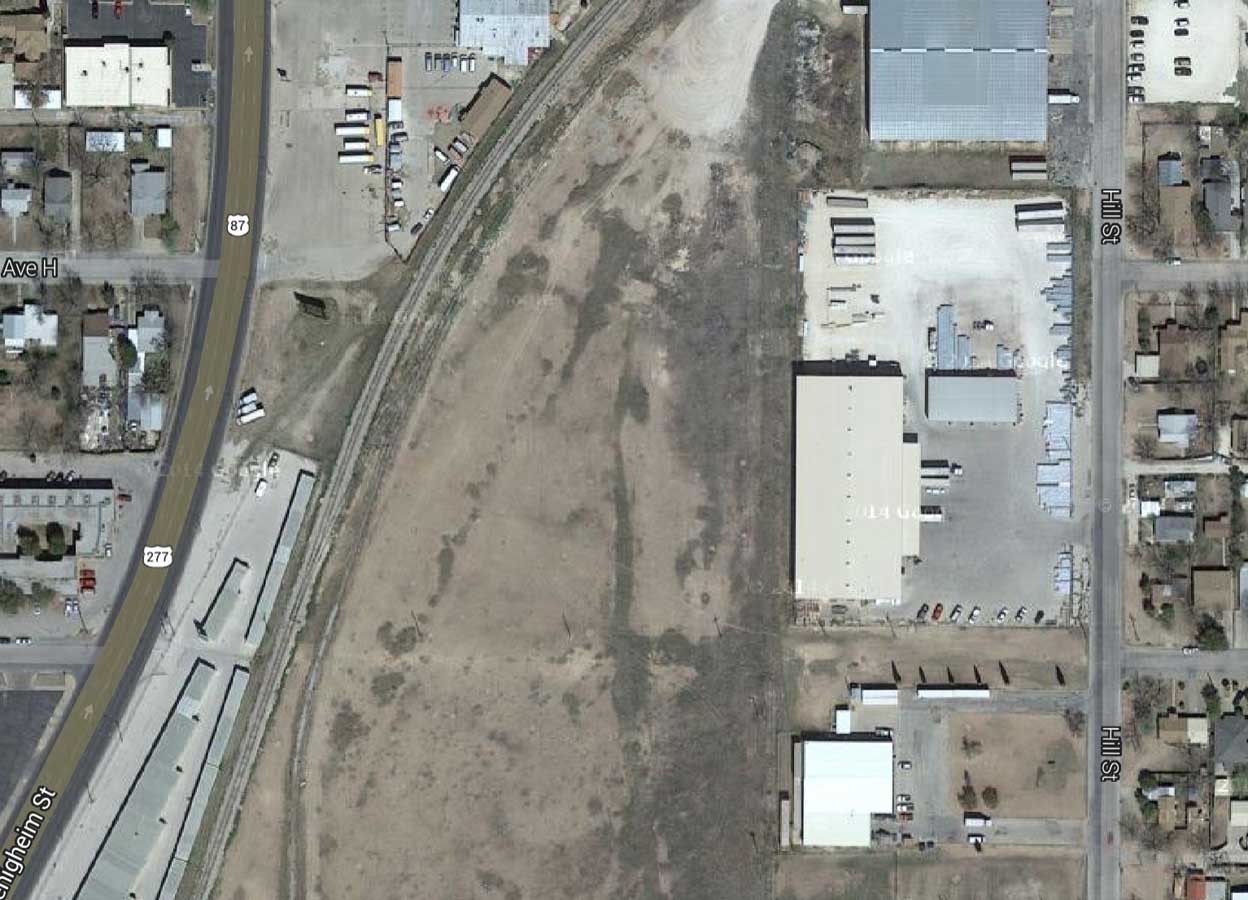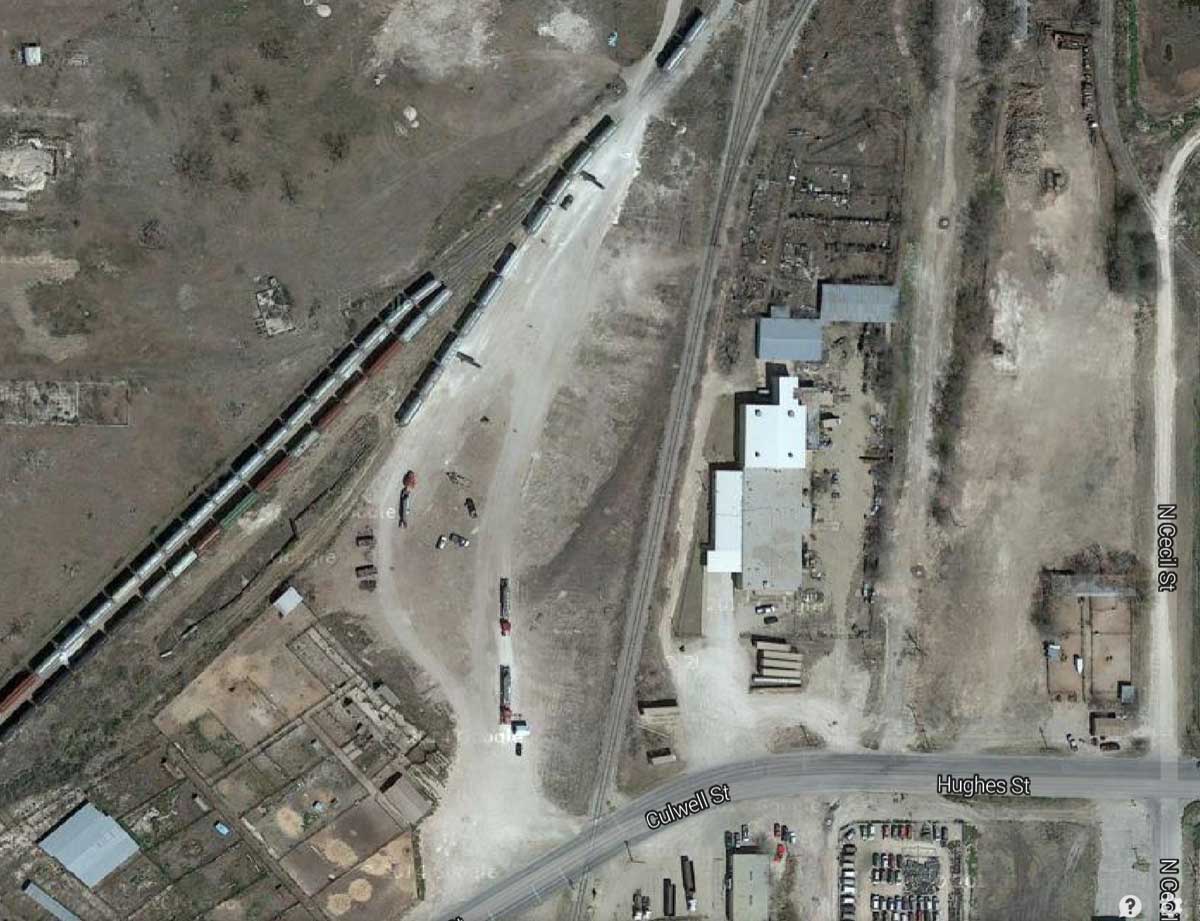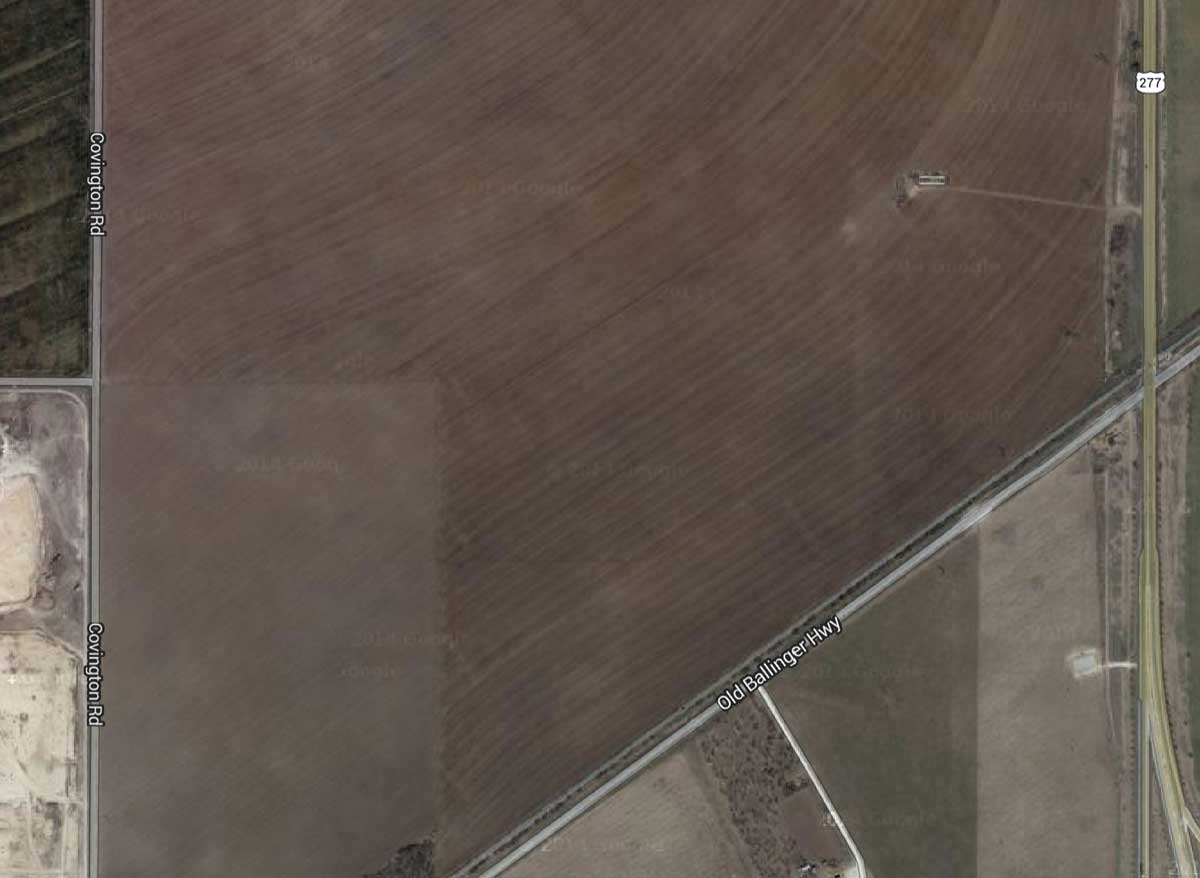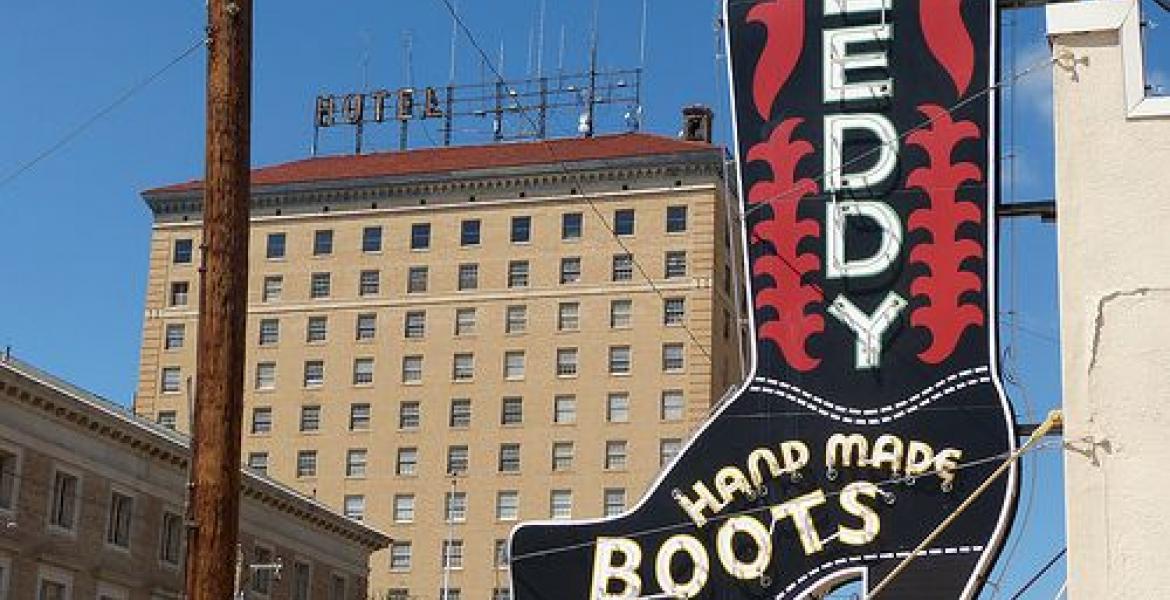The San Angelo frac sand controversy involves many moving parts, multiple agendas, antagonists and protagonists. If you’re like most people who don’t closely follow city politics, you may be confused about the players, the sites, and the real issues that matter.
In order to clarify the issue, this will walk you through the three frac sand sites, one already operating, and two proposed, and sprinkle some anecdotal information throughout to give you a taste of the frac sand controversy in San Angelo.
Hill Street
This is the epicenter of the frac sand controversy, and why you’ve probably heard about this issue at all.
Local entrepreneur Lee Pfluger owns a landlocked, 5.5-acre triangular-shaped piece of property between Hill Street and U.S. 277, behind Mayfield Paper, the House of Faith, and the Concho Valley Food Bank. The land is of little use, except that the property has access to rail.
Pfluger, thinking like an entrepreneur does, wanted to bring more value to his asset, and he believed that the access to the rail made the property unique. The trains are rolling through town now, usually hauling materials and supplies for the oil field west of here. The bulk of the train shipments contain frac sand. The sand is dry, clean, fine, and silica-based for hydraulic fracturing of oil out of the ground.
Pfluger’s idea was to build, or facilitate the building of, a facility that unloads sand from rail cars and onto 18-wheelers. The trucks conduct round-robin hauls to the oil fields, and then back to town to obtain another load.
Sometime over the summer, Pfluger asked the City of San Angelo for a ruling on whether or not what he was planning to do was legal in regards to the zoning ordinances. His Hill Street land is zoned for “Light Manufacturing”.
The planners at the city ruled:
“The 5.510-acre tract .... is within the “Light Manufacturing Zone District.” The transloading and storing of products used in the oil and gas industry is a permitted use in this zoning district provided that these products are not solid, liquid, or hazardous waste. According to the owner of the property, the product to be transloaded is a type of sand which, per his correspondence with the City, is “pure, devoid of impurities and dry when it will arrive at the subject property to be transloaded into enclosed 18 wheelers.” Based on this information, the Planning Division has determined that the product to be transloaded (i.e. sand) would not be considered solid, liquid, or hazardous waste, and would thus be permitted as “Warehouse and Freight Movement” in the Light Manufacturing Zone District.”
In August, a flyer was mailed anonymously to all of the media outlets, as well as to residents living in homes who may be impacted by the sand in the air and truck traffic.

Above: The Hill Street site as seen on Google Earth, Jan. 24. 2015. (Google)
City Director of Zoning and Planning Patrick Howard stood firm by his team’s decision to allow Pfluger's sand depot, saying that it was not his job to create ordinances, but to interpret them. He said he welcomed, and intended for, the Zoning Board of Adjustments to re-evaluate his ruling that he said was made based upon his reading of the current zoning ordinances.
When health risks of blowing sand in the air and increased truck traffic became known to the general public, citizens were outraged and lined up in the hundreds to express their opposition to allowing a frac sand depot on Hill Street at an Oct. 2014 city council meeting. Citizens groups and neighborhood groups organized and hired lawyers. Leading the opposition is oil and gas attorney and former city councilman from the Santa Rita area, H.R. “Winkie” Wardlaw, III. The attorney representing Pfluger is Jackson Walker’s Sam Allen.
Wardlaw alleges that State Rep. Drew Darby was also hired by Pfluger and was instrumental in getting the Texas Commission on Environmental Quality to look the other way, allowing Pfluger's sand depot. Both Darby and Darby's chief of staff Jason Modglin deny that the lawmaker made any such deal, or facilitated one. "Any rumor that TCEQ was directed or asked to do something other than their statutory responsibility is false," Modglin said. Darby, who is on staff at Jackson Walker, denies he was hired by Pfluger.
The stage was set for a showdown, now scheduled for Feb. 2, 1:30 p.m. at the Zoning Board of Adjustments meeting inside the McNease Convention Center.
Hughes/Culwell Street
This is an existing frac sand trans-loading facility that has been used as an example of what the controversial proposal for Hill Street could become. There are multiple spur tracks laid in parallel at this location, and frac sand trucks can be seen there day and night loading sand from the train cars there. A Dallas-based company, Pinnacle Sands, LLC, operates the facility.

Above: The Hughes/Culwell Street facility is in operation today and is operated by Pinnacle. (Google Earth)
Land there is leased by Pinnacle from a number of landlords, including Lee Pfluger. Pinnacle also purchased property adjacent to the leased parcels for the facility. City Councilman Rodney Fleming was the real estate broker on that deal for Pinnacle’s parent, earning about $14,000 in real estate sales commissions. Fleming has not responded to two phone calls inquiring about this. He did, however, confirm that he had conducted business with Pinnacle at the Jan.5 council meeting.
Councilwoman Elizabeth Grindstaff is the Vice President of Sales and Marketing for Texas Pacifico Grupo Mexico, the railroad company that operates on the state-owned tracks adjacent to each of the three locations. Her company leases rail track to Pinnacle. Grindstaff has on numerous occassions volunteered knowledge of her employment with the railroad company. At the Jan. 5 meeting, in open session, Grindstaff asked for the city attorney's opinion whether or not she should recuse herself from discussions and the vote on issues related to Pinnacle, Texas-Pacifico's customer. The city attorney said she did not have to, but Councilman Fleming insisted that she do. Grindstaff left the room.
Proposed 175-Acre Pinnacle Site on Old Ballinger Highway
This proposed 175-acre site for the largest trans-loading facility near San Angelo will be operated by Pinnacle as well. Though the land is outside the city limits, the landlord has a requirement that before anything other than agriculture or a ranch house is built on the property, the owner must request annexation by the City of San Angelo. The petition for annexation has been accomplished and the city council voted 6-0 in favor of annexation at the Jan. 5 council meeting. (Grindstaff recused herself from the entire discussion and vote, but Fleming stayed and voted).
Law requires that annexation ordinances have two readings before adoption, and the second reading was scheduled for this past Tuesday’s meeting. However, council delayed the second reading at Pinnacle’s request. The final annexation vote will probably happen at the next council meeting, Feb. 3.
The council expressed concerns over the annexation of this property at the Jan. 6 meeting. Fleming was against it, and Mayor Dwain Morrison said he had reservations about the amount of water the facility would consume.
Morrison said after the Jan. 20 council meeting that Pinnacle had met with each member of council separately and addressed the concerns aired at the Jan. 5 meeting. Morrison said that Pinnacle offered to pave the operating area to avoid any water usage to wet-down the dust. The mayor estimated that the Pinnacle annexation has enough votes to pass.

Above: The proposed site for the largest frac sand trans-loading facility in San Angelo encompasses 175 acres at the corner of US 277 and Old Ballinger Highway. The city has been petitioned to annex this land. (Google Earth)
A Pinnacle spokesman said that the company was petitioning for annexation because of the covenant requiring the petition that is attached to the now-county land where they will build the facility. Whether the land is annexed by the city or not has no bearing on if the facility is built or not.
If the city annexes the property, it can collect property taxes on the improved industrial land. City staff noted at the last meeting that the city’s master development plan had the property earmarked for industrial development.
Is a Deal in the Works?
Comparing land descriptions in city agenda items suggests that something is in motion concerning the Hill Street property before the Feb. 2 ZBA meeting.
City council deliberated on the purchase, exchange, or sale of land with a property description similar to, or in the vicinity of, Pfluger’s Hill Street land in closed executive session Jan. 20.
From the executive session agenda item for the Jan. 20 council meeting:
Section 551.072 to deliberate the purchase, exchange, lease, or value of real property regarding: (a) a parcel of land out of an unopened portion of Ave. H and small tracts out of J Ebert Survey and U Haul Development Addition, City of San Angelo; and (b) a parcel of land out of J Ebert Survey, City of San Angelo.
The land description is similar to the description in the agenda for the Feb. 2 ZBA meeting, describing the Hill Street property:
An appeal from Jesse Martinez, et al (Mark Thieman, Dennis Grafa, Chris Cornell, HR Wardlaw III) alleging error in the determination of the Planning & Development Services Director that a “proposed silica frac sand operation is permitted in the Light Manufacturing zoning district” on property described as “5.510 acres tract occupying the J. Ebert Survey 680, Abstract 0172 (#39 Orient Branch City and SAISD) in San Angelo, Tom Green County, Texas.”
No action was taken from any item discussed in executive session at the last council meeting.
Is something in the works for Pfluger’s property off Hill Street?
Wardlaw said he thought Pfluger was up to making a deal. Pfluger denied any deal was made when asked Friday afternoon.
Pfluger also elaborated on the Pinnacle land deal on the Old Ballinger Highway. He said he’s for annexation because it will be in the best interest of the city.
This summary barely scratches the surface of the issue and the players involved. But this is what we have been able to verify for the public.
Subscribe to the LIVE! Daily
Required






Comments
Listed By: J H
It can't be solid, liquid or hazardous. And they determined that sand is none of those...that means that now sand, since it's not solid or liquid is a gas! Very interesting interpretation of physical properties.
- Log in or register to post comments
PermalinkListed By: Joe Hyde
What the planners said was that it wasn't solid or liquid poop.
- Log in or register to post comments
PermalinkListed By: Jules Beesley
If silica frac sand is not hazardous, then why did OSHA release a hazard alert warning of the health risks posed by exposure to silica franc sand? The fact that airborne crystalline silica can cause silicosis, an incurable and often deadly disease, has yet to be reported in any news article on this matter.
"The National Institute for Occupational Safety and Health (NIOSH) identified exposure to airborne silica as a health hazard to workers conducting some hydraulic fracturing operations during recent field studies"
https://www.osha.gov/dts/hazardalerts/hydraulic_frac_hazard_alert.html
- Log in or register to post comments
PermalinkListed By: Doctor Ding-bat
Good grief, if this sand issue causes such hemmoroids in a lot of you folks, then according to the U.S. Census Bureau, there are 19,354 cities in the United States that all you pisser and moaners can pack up and move to......
- Log in or register to post comments
PermalinkListed By: Amanda Reynolds
Petition AGAINST sand depot http://www.petitionbuzz.com/petitions/citizensagainstsand
- Log in or register to post comments
PermalinkListed By: Green Mesquite
Doc:
Why you got to be such a jerk about people writing and voicing their concerns about the hazards (No, not the Dukes) of frac sand? The stuff is most likely harmful to human health, and not a matter to belittling others about. If someone is concerned about a possible health hazard (again, not the Dukes), perhaps you could volunteer to collect health impact data at the sources, in order to provide some comfort or relief to those concerned. I would say you're being an azzhut, but that would not be nice of me.
- Log in or register to post comments
PermalinkPost a comment to this article here: